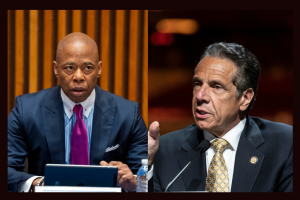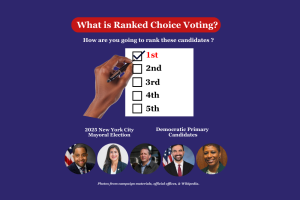By Esther Claudette Gittens | Photo Copyright IQ INC.
New York City’s 2025 mayoral race is shaping up to be a compelling contest, particularly within the Democratic primary, which often serves as the de facto general election in the heavily Democratic city. With incumbent Mayor Eric Adams opting to run as an independent, the Democratic field is wide open, leading to a dynamic and somewhat unpredictable primary. The introduction of ranked-choice voting (RCV) for primary and special elections further complicates the electoral landscape, demanding new strategies from candidates and offering voters a more nuanced way to express their preferences.
Who is Leading the Polls and Why?
As of late May 2025, former Governor Andrew Cuomo has consistently held a lead in various Democratic primary polls. An Emerson College Polling/PIX11/The Hill survey from May 28th, 2025, showed Cuomo with 35% of the first-round ballot, followed by State Representative Zohran Mamdani at 23%. Other notable candidates, including Comptroller Brad Lander, former State Representative Scott Stringer, and City Council Speaker Adrienne Adams, are polling in single digits.
Cuomo’s lead can be attributed to several factors. Despite the controversies that led to his resignation as governor, he retains significant name recognition and a built-in base of support, particularly among older voters (66% support from those over 50), Black voters (74%), and women (58%). His long history in state and federal politics gives him a recognizable profile that newer candidates struggle to match. Some voters may also view him as a strong, experienced leader capable of tackling the city’s pressing issues.
However, Zohran Mamdani’s recent surge is a significant development. His support jumped from a mere 1% in February to 23% in May, demonstrating a clear momentum. Mamdani appeals strongly to a different demographic: voters under 50 (61%), white voters (57%), and college-educated voters (58%). His progressive platform and fresh face likely resonate with those looking for a departure from traditional political figures. This stark demographic split highlights a key ideological and generational divide within the Democratic electorate.
The remaining candidates, while possessing significant political experience, have struggled to gain significant traction in the initial polling. Brad Lander, as the current City Comptroller, has a citywide profile, but his support is not consolidating to the degree seen with Cuomo or Mamdani. Adrienne Adams, the City Council Speaker, also holds a powerful position, but it hasn’t translated into broad primary support yet.
How Does Ranked-Choice Voting Impact Each Candidate?
Ranked-choice voting, where voters can rank up to five candidates in order of preference, fundamentally alters campaign strategies and the path to victory. It encourages candidates to seek not just first-choice votes but also second and third preferences, leading to a more collaborative, or at least less overtly combative, primary.
For Andrew Cuomo: While Cuomo enjoys a strong first-choice lead, RCV introduces a vulnerability. His high unfavorability ratings (47%) among New York City voters mean that while many might rank him first, a significant portion of the electorate might refuse to rank him at all, or place him at the very bottom of their preferences. To win outright, he needs to secure over 50% of the vote. If he falls short, he will need to pick up second and third choices from eliminated candidates. The Emerson poll simulation shows him reaching 54% after ten rounds, suggesting he can cross the threshold, but Mamdani is close behind at 46%, indicating the importance of those lower preferences. Cuomo’s challenge is to persuade voters who might not be enthusiastic about him as a first choice to still consider him as a viable backup.
For Zohran Mamdani: RCV is a significant advantage for Mamdani. His rapid ascent suggests he is tapping into a vein of support that could be highly motivated to rank him. Furthermore, as a progressive candidate, he is more likely to be a common second or third choice for voters whose initial preferences are other progressive or left-leaning candidates like Brad Lander, Scott Stringer, or Zellnor Myrie. The Emerson poll notes that Mamdani is winning second-choice votes nearly 2-to-1 against Cuomo, which is crucial in RCV. His strategy will likely involve emphasizing common ground with other progressive candidates and encouraging voters to rank multiple progressive choices.
For Other Candidates (Lander, Stringer, Adams, Myrie, Ramos): For candidates with lower first-choice support, RCV is their lifeline. Their path to victory is less about outright winning the first round and more about accumulating enough second and third preferences to survive successive rounds of elimination. This incentivizes them to run positive campaigns and forge informal alliances with other candidates, seeking “cross-endorsements” or at least friendly mentions. For example, Brad Lander, as a progressive, would likely benefit from Mamdani voters ranking him second or third, and vice versa. Adrienne Adams, as the City Council Speaker, represents the establishment wing and would be looking for votes from more moderate Democrats. Their campaigns will need to focus on distinguishing themselves enough to be a first choice for some, while also appealing broadly enough to be a palatable second or third choice for many others.
The Risk of Corroboration
The term “corroboration” in the context of elections can be understood in a few ways, primarily related to strategic voting, shared messaging, and tacit alliances among candidates. In a ranked-choice system, the risk of negative corroboration (e.g., voters being turned off by a candidate’s associations) is often outweighed by the incentive for positive collaboration.
Strategic Voting: Voters can engage in strategic voting in RCV. For instance, a voter who strongly prefers a progressive candidate might still rank a more moderate candidate second or third if they believe that candidate has a better chance of defeating a candidate they strongly oppose. This is less about “corroboration” of a candidate’s platform and more about pragmatic decision-making within the system.
Candidate Collaboration and Shared Platforms: RCV incentivizes candidates to seek common ground and even make informal “cross-endorsements” or recommendations for second and third choices. This can be seen as a form of positive corroboration, where candidates effectively tell their supporters that other candidates are acceptable alternatives. This reduces negative campaigning and fosters a more cooperative environment. For example, progressive candidates might implicitly or explicitly encourage their voters to rank other progressive candidates to maximize their collective chances against a more conservative Democrat. The Working Families Party (WFP), a significant progressive force in NYC, has already stated its intention to leverage RCV strategically and has explored requiring candidates to work together and discourage voters from ranking certain candidates, like Cuomo.
The “Anybody But Cuomo” Factor: For some segments of the Democratic electorate, there’s a strong “Anybody But Cuomo” sentiment due to his past controversies. This creates a de facto collaboration among candidates who seek to appeal to this anti-Cuomo vote. These candidates might not explicitly “corroborate” each other’s platforms, but their shared opposition to Cuomo creates a dynamic where voters are likely to rank multiple non-Cuomo candidates highly.
Challenges for the Frontrunner: For a frontrunner like Cuomo, the risk of negative corroboration comes from his past actions and negative public perception. If other candidates are successful in framing him as an unacceptable choice, it could actively dissuade voters from ranking him at all, even as a lower preference. His campaign will need to counteract this by focusing on his experience and ability to lead, rather than engaging in direct attacks that could alienate potential second-choice voters.
In conclusion, the NYC Mayoral Democratic Primary is a fascinating case study in the impact of ranked-choice voting. While Andrew Cuomo currently holds a leading position, the surging support for Zohran Mamdani and the inherent dynamics of RCV mean that the race is far from decided. The need for candidates to appeal to a broader base for second and third choices fosters a more collaborative, less adversarial primary environment, and the strategic decisions made by campaigns, both individually and in tacit alliances, will ultimately determine who emerges as the Democratic nominee for Mayor of New York City. The risk of negative “corroboration” exists, but the system’s incentives for positive engagement and coalition-building are likely to play a more dominant role in the final outcome.
Click Here to Schedule a Consultation with Figeroux & Associates Today!



